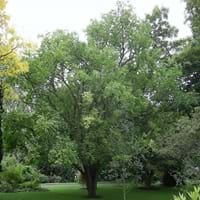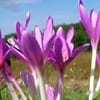Life Span
Perennial
Perennial
Type
Bulb or Corm or Tuber
Tree
Origin
Mediterranean, Turkey
China
Types
Not available
Not Available
Number of Varieties
Not Available
Habitat
Lawn, meadows, Sunny Edge, Woodland Garden
Dappled Shade, Sunny Edge, Woodland Garden Secondary
USDA Hardiness Zone
6-9
4-8
Sunset Zone
21,22
A1, A2, A3, H1, H2, 1a, 1b, 2a, 2b, 3a, 3b, 4, 5, 6, 7, 8, 9, 10, 11, 12, 13, 14, 15, 16, 17, 18, 19, 20, 21, 22, 23, 24
Habit
Clump-Forming
Upright/Erect
Minimum Height
Not Available
Minimum Width
Not Available
Flower Color
Fuchsia, Rose
Yellow
Flower Color Modifier
Bicolor
Bicolor
Fruit Color
Not Available
White
Leaf Color in Spring
Green
Green
Leaf Color in Summer
Light Green
Green
Leaf Color in Fall
Several shades of Green
Yellow
Leaf Color in Winter
Light Green
Not Available
Leaf Shape
Long Broad
Heart shaped, toothed with three to five lobes
Plant Season
Spring, Fall
Fall
Sunlight
Full Sun, Partial Sun
Full Sun
Growth Rate
Medium
Very Fast
Type of Soil
Loam
Clay, Loam, Sand
The pH of Soil
Acidic, Neutral
Acidic, Neutral, Alkaline
Soil Drainage
Well drained
Well drained
Bloom Time
Late Summer, Early Fall
Early Spring
Tolerances
Drought
Pollution, Drought, Salt, Soil Compaction
Where to Plant?
Container, Ground, Pot
Ground
How to Plant?
Corms or bulbs, Seedlings
Seedlings, Stem Cutting
Plant Maintenance
Low
Medium
Watering Requirements
Do Not over Water, Keep the ground moist but not water-logged
Needs small amount of water
In Summer
Lots of watering
Lots of watering
In Spring
Moderate
Moderate
In Winter
Average Water
Average Water
Soil pH
Acidic, Neutral
Acidic, Neutral, Alkaline
Soil Type
Loam
Clay, Loam, Sand
Soil Drainage Capacity
Well drained
Well drained
Sun Exposure
Full Sun, Partial Sun
Full Sun
Pruning
Cut or pinch the stems, Remove damaged leaves, Remove dead flowers, Remove dead leaves
Remove damaged leaves, Remove dead branches, Remove dead leaves
Fertilizers
All-Purpose Liquid Fertilizer, fertilize in summer
Apply 10-10-10 amount
Pests and Diseases
Slugs
Armillaria root rot, Bacterial Blight
Plant Tolerance
Drought
Drought
Flowers
Showy
Insignificant
Flower Petal Number
Single
Single
Foliage Texture
Coarse
Medium
Foliage Sheen
Not Available
Matte
Attracts
Bees, Butterflies
Insects, Silkworms
Allergy
poisonous if ingested, Toxic if not prepared properly
Pollen, Severe allergen
Aesthetic Uses
Beautification, Cottage Garden, Showy Purposes
Not Used For Aesthetic Purpose
Beauty Benefits
Removes pimples
Hair-growth, Skin whitening
Environmental Uses
Air purification
Air purification
Medicinal Uses
Arthritis, Gout, Itching
Analgesic, Anthelmintic, Antibacterial, Astringent, Diuretic, Expectorant, Odontalgic
Part of Plant Used
Bulbs, Flowers, Seeds
Fruits, Inner Bark, Leaves
Other Uses
Used as Ornamental plant, Used for its medicinal properties
As a tea substitute, Used as a thickener in soups, Used to make baskets
Used As Indoor Plant
No
No
Used As Outdoor Plant
Yes
Yes
Garden Design
Alpine, Container, Mixed Border, Rock Garden / Wall
Shade Trees, Street Trees
Botanical Name
Colchicum autumnale
MORUS alba
Common Name
Autumn Crocus, meadow saffron, naked lady
White Mulberry
In Hindi
शरद ऋतु का पौधा
सफेद शहतूत
In German
Herbstzeitlose
Weiß Mulberry
In French
colchique d'automne
Mûrier blanc
In Spanish
cólquico
White Mulberry
In Greek
φθινόπωρο κρόκος
Λευκή Μουριά
In Portuguese
aftomn gema
Branco Mulberry
In Polish
aftomn żółtka
Biały Mulberry
In Latin
aftomn vitellus
Morus alba
Phylum
Magnoliophyta
Magnoliophyta
Class
Liliopsida
Magnoliopsida
Family
Liliaceae
Moraceae
Clade
Angiosperms, Monocots
Not Available
Subfamily
Not Available
Not Available
Number of Species
Not Available
Importance of Autumn Crocus and White Mulberry
Want to have the most appropriate plant for your garden? You might want to know the importance of Autumn Crocus and White Mulberry. Basically, these two plants vary in many aspects. Compare Autumn Crocus and White Mulberry as they differ in many characteristics such as their life, care, benefits, facts, etc. Every gardener must at least have the slightest clue about the plants he wants to plant in his garden. Compare their benefits, which differ in many ways like facts and uses. The medicinal use of Autumn Crocus is Arthritis, Gout and Itching whereas of White Mulberry is Analgesic, Anthelmintic, Antibacterial, Astringent, Diuretic, Expectorant and Odontalgic. Autumn Crocus has beauty benefits as follows: Removes pimples while White Mulberry has beauty benefits as follows: Removes pimples.
Compare Facts of Autumn Crocus vs White Mulberry
How to choose the best garden plant for your garden depending upon its facts? Here garden plant comparison will help you to solve this query. Compare the facts of Autumn Crocus vs White Mulberry and know which one to choose. As garden plants have benefits and other uses, allergy is also a major drawback of plants for some people. Allergic reactions of Autumn Crocus are poisonous if ingested and Toxic if not prepared properly whereas of White Mulberry have Pollen and Severe allergen respectively. Having a fruit bearing plant in your garden can be a plus point of your garden. Autumn Crocus has no showy fruits and White Mulberry has showy fruits. Also Autumn Crocus is not flowering and White Mulberry is not flowering . You can compare Autumn Crocus and White Mulberry facts and facts of other plants too.





